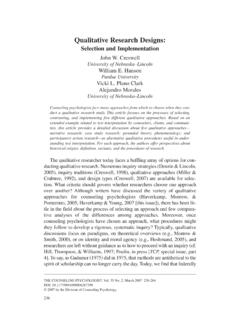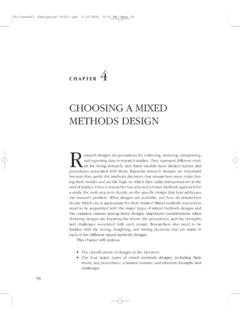Transcription of Survey Research - Stanford University
1 CHAPTER NINE Survey Research PBNNY S. VISSBR, JON A. KROSNICK, AND PAUL J. LAVRAWS Social psychologists have long recognized that every method of scientific inquiry is subject to limitations and that choosing among Research methods inherently involves trade-offs. With the control of a laboratory experiment, for example, comes an artificiality that raises questions about the generalizability of results. And yet the 'naturalness" of a field study or an observa- tional study can jeopardize the validity of causal infer- ences. The inevitability of such limitations has led many methodologists to advocate the use of multiple meth- ods and to insist that substantive conclusions can be most confidently derived by triangulating across mea- sures and methods that have nonoverlapping strengths and weaknesses (see, , Brewer, this volume, Ch.)
2 1; Cpmpbell 6 Piske, 1959; Campbell 6 Stanley, 1963; Cook 6 Campbell, 1969; Crano 6 Brewer, 1986; B. Smith, this volume, Ch. 2). This chapter describes a Research methodology that we believe has much to offer social psychologists in- terested in a multimethod approach: Survey Research . Survey Research is a specific type of field study that in- volves the collection of data from a sample of ele- ments ( , adult women) drawn from a well-defined population ( , all adult women living in the United States) through the use of a questionnaire (for more lengthy discussions, see Babbie, 1990; Fowler, 1988; This chapter was completed while the second author was a Fellow at the Center for Advanced study in the Behavioral Sciences, supported by National Science Foundation Grant SBR-9022192.
3 Correspondence should be directed to Penny S. Visxr, Department of Psychology, Princeton University , Prince- ton, New Jersey 08544 (e-mail: ). or Jon A. Krosnick. Department of Psychology, Ohio State University , 1885 Neil Avenue, Columbus, Ohio 43210 (e-mail: Krosnick Frey, 1989; Lavrakas, 1993; Weisberg, Krosnick, 6 Bowen, 1996). We begin the chapter by suggesting why Survey Research may be valuable to sodal psychologists and then outline the utility of various study designs. Next, we review the basics of Survey sampling and questionnaire design .
4 Fiy, we describe procedures for pretesting questionnairesand for data collection. REASONS FOR SOCIAL PSYCHOLOGISTS TO CONDUCT Survey RBSEARCH Social psychologists are interested in understanding how people influence, and are influenced by, their so- cial environment. And to the extent that social psy- chological phenomena are universal across different types of people, it makes little difference precisely with whom social psychological Research is conducted - even data collected from samples that are decidedly un- representative of the general population can be used to draw inferences about that population.
5 In recent years, however, psychologists have be- come increasingly sensitive to the impact of disposi- tional and contextual factors on human thought and social behavior. Instead of broad statements about uni- versal processes, social psychologists today are far more likely to offer qualified accounts of which people, un- der which conditions, are likely to exhibit a partic- ular psychological phenomenon or process. And ac- cordingly, social psychologists have increasingly turned their attention to interactions between various social psychological processes and characteristics of the indi- vidual, such as personality traits, identification with a social group or category, or membership in a distinct culture.
6 In many cases, the nature of basic social psy- chological processes has been shown to depend to a large degree on characteristics of the individual. 2U PENNY S. VISSER, JON A. KROSNICK, AND PAUL J. LAVRAKAS The process by which attitude change occurs, for example, has been shown to differ for people who are low and high in what Petty and Cacioppo ( 1986) have termed 'need for cognition," a general enjoyment of and preference for effordul thinking. Attitude change among people high in need for cognition tends to be mediated by careful scrutiny of the arguments in a per- suasive appeal, whereas attitude change among people low in need for cognition tends to be based on cues in the persuasive message or context, such as the attrac- tiveness of the source.
7 Similarly, attributions have been shown to differ de- pending on social group membership (see, , Hew- stone, Bond, 6 Wan, 1983). People tend to attribute positive behaviors by members of their own social group or category to stable, internal causes. Those same positive behaviors performed by a member of a differ- ent social group, however, are more likely to be at- tributed to transitory or external factors. According to much recent Research , culture may also moderate many social psychological phenomena. Markus and Kitayama (1991), for example, have ar- gued that members of different cultures have differ- ent construals of the self and that these differences can have a profound impact on tlye nature of cogni- tive, emotional, and mo@vational pmceses.
8 Similarly, Nisbett and his colleagues'(Coheh, Nisbett, Bowdle, 6 Schwan, 1996; Nisbra, 1993; Nisbett 6 Cohen, 1996) have explored what they tcnned the 'culture of honorw of the American South and have demonstrated marked differences in the cognitive, eimotiod, behavioral, and even physiological reactions af southem men (relative to their northern counterparts) when confronted with insult. These kinds of process-by-indi--difference in- teractions suggest that precisely who participates in so- cial psychological Research can have a profound im- pact on what results are obtained.
9 And of course, for the vast majority of social psychological Research , that 'who" has been the infamous college sophomore. Sears (1986) has argued that the field's overwhelming re- liance on this narrow base of Research -ts may represent a serious problem for sodal psychol- ogy. Pointing to various attributes that are charac- teristic of young adults, Sears (1986) suggested that the 'college sophomore" partidpant pool is unrep- resentative of the general population in a num- ber of important ways. Among other things, young adults are more susceptible to attitude change (Alwin, Cohen, 6 Newcomb, 1991; Glenn, 1980; Krosnick 6 Alwin, 1989; Sears, 1983), exhibit less stable person- ality traits (Caspi, Bem, 6 Elder, 1989; Costa, McCrae, 6 Arenberg, 1983; Nesselroade 6 Baltes, 1974), have more weakly established self-images (Mortimer, Pinch, 6 Kumka, 1982), and have less well-developed social identities (Alwin et al.)
10 , 1991) than-do older adults. Because of these kinds of differences, Sears (1986) argued, the field's reliance on participant pools of college-aged adults raises questions about the gener- ahability of some findings from social psychological laboratory Research and may have contributed to a dis- torted portrait of 'human nature." However, the evi- dence Sears (1 986) cited largely reveals the prevalence of certain characteristics ( , the frequency of atti- tude change or the firmness of social identities), rather than differences in the processes by which these char- acteristics or others emerge in different age groups.













